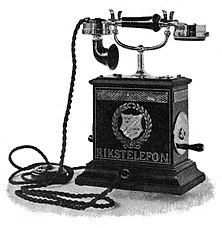Telephone prehistory
Mechanical devices
Before the invention of electromagnetic telephones, there were mechanical devices for transmitting spoken words over a greater distance than that of normal speech. The very earliest mechanical telephones were based on sound transmission through pipes or other physical media. Speaking tubes long remained common, including a lengthy history of use aboard ships, and can still be found today.A different device, the tin can telephone, or 'lover's phone', has also been known for centuries. It connected two diaphragms with a taut string or wire, which transmitted sound by mechanical vibrations from one to the other along the wire, and not by a modulated electrical current. The classic example is the children's toy made by connecting the bottoms of two paper cups, metal cans, or plastic bottles with string.
Electrical devices
Main article: Electrical telegraph
The telephone emerged from the creation of, and successive improvements to the electrical telegraph. In 1804 Catalan polymath and scientist Francisco Salvá i Campillo constructed an electrochemical telegraph.[1] An electromagnetic telegraph was created by Baron Schilling in 1832. Carl Friedrich Gauß and Wilhelm Weber built another electromagnetic telegraph in 1833 in Göttingen.The first commercial electrical telegraph was constructed by Sir William Fothergill Cooke and entered use on the Great Western Railway in England. It ran for 13 miles from Paddington station to West Drayton and came into operation on April 9, 1839.
Another electrical telegraph was independently developed and patented in the United States in 1837 by Samuel Morse. His assistant, Alfred Vail, developed the Morse code signaling alphabet with Morse. America's first telegram was sent by Morse on January 6, 1838, across two miles of wiring.
During the second half of the 19th century inventors tried to find ways of sending multiple telegraph messages simultaneously over a single telegraph wire by using different modulated audio frequencies for each message. These inventors included Charles Bourseul, Thomas Edison, Elisha Gray, and Alexander Graham Bell. Their efforts to develop acoustic telegraphy in order to significantly reduce the cost of telegraph messages led directly to the invention of the telephone, or 'the speaking telegraph'.













